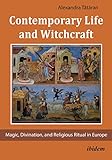Contemporary Life and Witchcraft : Magic, Divination, and Religious Ritual in Europe.
Material type: TextPublication details: Stuttgart : Ibidem Press, 2016.Description: 1 online resource (225 pages)Content type:
TextPublication details: Stuttgart : Ibidem Press, 2016.Description: 1 online resource (225 pages)Content type: - 3838267788
- 9783838267784
- 133.43094
- BX320.2 .T383 2016
- online - EBSCO
| Item type | Current library | Call number | URL | Status | Notes | Barcode | |
|---|---|---|---|---|---|---|---|
 eBook
eBook
|
Biblioteca "Angelicum" Pont. Univ. S.Tommaso d'Aquino Nuvola online | online - EBSCO (Browse shelf(Opens below)) | Online access | Not for loan (Accesso limitato) | Accesso per gli utenti autorizzati / Access for authorized users | (ebsco)1948926 |
Print version record.
Intro; Contents; Introduction; Researching the Witchcraft Discourse; Writing about Contemporary Witchcraft; Chapter 1: Difficult Life Situations and Witchcraft; 1.1 Witchcraft Situations and Reasons for Entering the Witchcraft Discourse; Delay of Marriage; Unhappy Marriage, Problematic Love Relationship; Inexplicable Illnesses, 'Mal de Vivre'; Milk Mana and Fertility Transfer; 1.2 Symptoms, Signs, and Signals of a Witchcraft Situation; The Pink Dress; 1.3 Entering the Witchcraft Discourse; Social Discourse and Personal Choice
The Apotropaic Dimension of Witchcraft Situations: Ritual Gestures and Interior MemoryBuilding the Narrative; Chapter 2: The Actors in Witchcraft Situations; 2.1 The Witchcraft Discourse: General Lines and Specific Actors; 2.2 Roles and Actors; Afflicted Actors; The 'Incidental Diagnostician'; The Fortune Teller; The Traditional Unwitcher and Magical Healers; The Orthodox Priest or Monk; 2.3 Who are the Magical Aggressors?; Possessors of 'Grace'; The Regionalization of Witchcraft; Transmitting the Abnormal Gift; The Punishment of Witches; Chapter 3: Therapeutic Interventions
3.1 The Logic of the ApotropaicFaces of Fear and Cycles of Ritual Defense; Drawing Boundaries in Contemporary Witchcraft Discourse; 3.2 Forms of Therapeutic Ritual; The Evil Eye; Religious Unwitching; Informal Specialization; 3.3 Protection and Combat Limits; Chapter 4: Magic and Religion; 4.1 Magic, Religion, and Science as Key Concepts in Anthropology; 4.2 Social Change and Insecurity: Three Examples; France; Russia; Romania; Social Change and Witchcraft Discourse: Concluding Remarks; 4.3 Orthodox Religion and Magical Practice; Magic, Religion, and Processes of Secularization
Religion and Magical Practices under CommunismPost-communist Developments; Concluding Remarks
Witchcraft is very much alive in today's post-communist societies. Stemming from ancient rural traditions and influenced by modern New Age concepts, it has kept its function as a vibrant cultural code to combat the adversities of everyday life. Intricately linked to the Orthodox church and its rituals, the magic discourse serves as a recourse for those in distress, a mechanism to counter-balance misfortune and, sometimes, a powerful medium for acts of aggression. In this fascinating book, Alexandra Tataran skillfully re-contextualizes the vast and heterogenuous discourse on contemporary witchcr.


